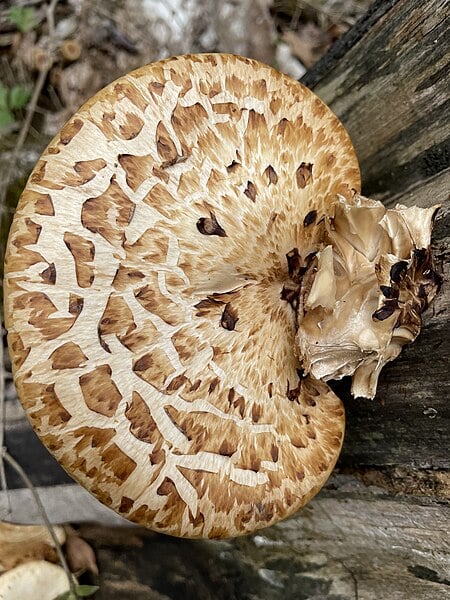Dryad’s Saddle Identification – Polyporus squamosus
Heads up
Dryad’s Saddle, scientifically referred to as Cerioporus squamosus, is a unique mushroom. You might recognize this mushroom by another name: pheasant’s back mushroom. “Dryad’s saddle” points to mythical tree spirits from Greek stories known as dryads. On the other hand, “pheasant’s back” talks about how the mushroom’s pattern resembles the back of a pheasant.
Dryad’s Saddle: Key Parts in Photos



Where to find it
You can find the Dryad’s Saddle in various parts of the world, from North America and Europe to even Australia and Asia. Within the U.S., they’re common to the east of the Rocky Mountains. Their peak appearance is during spring, but occasionally, they might pop up in the fall. The Dryad’s Saddle can be commonly spotted attached to dead logs and stumps or growing on living hardwood trees. You might even find them in clusters or alone. When they’re young, they feel soft to the touch, but as they age, they become tougher.
How to identify Dryad’s Saddle
- Cap: One of the main features you’ll notice about Dryad’s Saddle is its cap. This cap can vary in size, typically 12 inches in diameter. If you observe the cap’s position, you’ll notice that it’s either slightly pressed down (depressed) or offset from the center. The color is usually between yellow and tan. The top surface of this mushroom has small scale-like structures. These are called “squamules.”Under these scales, the flesh of the cap is white and has a tough texture.
- Tubes and Pores: When you flip the mushroom, the underside will reveal pores, which are openings of small tubes. These tubes, which are packed closely together, are a part of the mushroom’s spore-producing part. The pores start off as white but become cream-colored as the mushroom matures. These pores and tubes extend down the stalk.
- The Stipe: The Dryad’s Saddle has a rather thick and short stalk, or what’s called a stipe in botanical terms. This stipe can measure up to 2 inches in length and is usually attached to its growing surface in an off-center way.
- The Spores: the spores of Dryad’s Saddle are long and have a smooth oval shape, measuring around 11-15 x 4-5 µm.
Want to learn more?

Disclosure: This post includes affiliate links. If you make a purchase through these links, we may earn a commission at no extra cost to you. We appreciate your support, as it helps keep this website running. Alternatively, you can search for the book title on Amazon if you prefer not to use the links. Thank you for your understanding and support!
